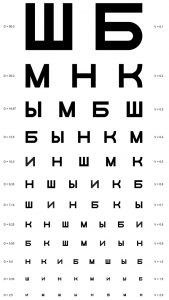An eye doctor is called an “окулист” or “офтальмолог” in Russian, or, sometimes and informally, a “глазной врач.” While the word оптика (ophthalmologic optics) is a common name for an eyeglass store in Russia, there is no exact Russian equivalent to the English word “optometrist,” which can be loosely translated as специалист по подбору очков.
One can записаться на прием к окулисту (make an appointment with an eye-doctor) to проверить зрение (have/get your eyes checked) or для проверки зрения (for an eye exam). An eye doctor can выписать рецепт на очки (write a prescription for glasses). Regarding prescriptions, the system is the same as in other parts of the world, such as in the US: for example минус пять (-5.0), плюс четыре семьдесят пять (+4.75), etc. in increments of 0.25. You can say у меня очки на минус (I have glasses for nearsightedness) or у меня очки на плюс (I have glasses for farsightedness).
 Like in English, Russians can use a slightly brusque expression, четырехглазый (“four-eyed”), to refer to people wearing glasses. Teasing bespectacled people is common at schools, which is why many teenagers стесняться носить очки (ashamed to wear glasses) and prefer to wear контактныелинзы (contact lenses) to disguise that they are близорукий (nearsighted) or дальнозоркий (farsighted). In addition, in recent years Russian TV has created the image of a «ботаник» в очках (nerd wearing glasses), which is a нудный человек (boring person) who is good at studies, but otherwise awkward.
Like in English, Russians can use a slightly brusque expression, четырехглазый (“four-eyed”), to refer to people wearing glasses. Teasing bespectacled people is common at schools, which is why many teenagers стесняться носить очки (ashamed to wear glasses) and prefer to wear контактныелинзы (contact lenses) to disguise that they are близорукий (nearsighted) or дальнозоркий (farsighted). In addition, in recent years Russian TV has created the image of a «ботаник» в очках (nerd wearing glasses), which is a нудный человек (boring person) who is good at studies, but otherwise awkward.
For eye exams, an оптометрическая таблица с буквами (eye chart with alphabet letters) is used. In Russia, this chart is called таблица Сивцева (Sivtsev’s Chart), named after the Soviet ophthalmologist that developed it. Interestingly, this chart has only seven letters from the Russian alphabet: Ш, Б, М, Н, К, Ы, И. There is another chart, which is usually placed to the right of Sivtsev’s chart, named таблица Головина (Golovin’s Chart; in English it is often known as a Japanese Vision Test). It consists of кольца Ландольта (Landolt Rings), which are rings with a gap pointed at various positions, usually left, right, down, up, and at 45° positions in between. The examined person must determine where the gap points.
An окулист might ask the following questions to a patient: “Какую самую нижнюю строчку Вы видите?” (What is the smallest row (of letters) that you can read?), or “В какойлинзе лучше видно?” (Which lens is clearer?). In the process of getting an eye exam, you may be asked to: “Прислонитесьлбом к верхней части и положите подбородок на опору” (Put your forehead on the top part (of the machine) and your chin on the chin rest); “поморгайте” (blink); “посмотрите вниз/вверх/налево/направо” (look down/up/left/right); “посмотрите прямо на меня” (look directly at me); or “посмотрите на стену за мной” (look at the wall behind me).
When заказывать очки (ordering glasses) in an оптика, you should choose your оправа (frames) first. Then, линзы (lenses) will be created according to the рецепт (prescription).
If a person needs контактные линзы, he/she might also need to buy физраствор (saline solution) and a контейнер для линз (contact lens case). Contact lenses can be одноразовые/мягкие (disposable/soft), which you wear for a day then throw away, or постоянные/ жесткие (permanent/hard) which you use for longer periods – from several weeks to several months.

Unlike in America, you can get glasses without a doctor’s appointment in Russia (although most shops will recommend that you see the doctor anyway). You just need to know your prescription. In larger cities, you can get contact lenses from торговые автоматы (vending machines) located in malls and supermarkets.
Посещение врача (a visit to the doctor) is likely to be much cheaper in Russia, but the glasses will likely be about the same cost as in America. Particularly for люди с астигматизмом (people with astigmatism), the lenses импортируются из фабрик за пределами России, часто из Японии (are imported from factories outside of Russia, often from Japan). For this reason, специальные линзы дляастигматизма (special lenses for astigmatism) are relatively expensive in Russia.
In addition to needing a prescription for glasses or contacts, a patient can have the following проблемы с глазами (problems with eyes): сухость и раздражение в глазах (dry, irritated eyes); зуд в глазах (itchy eyes); плохо видитили видит вещи расплывчато (bad or blurry vision), инородное тело в глазу (foreign object in eye), покраснение глаза (red eyes), боль вглазах (pain in eyes), or слезятся глаза(watering eyes), which can be caused by закупорка слезных протоков (blocked tear ducts). Or you may have a problem with some other part of your eye: зрачок (pupil), радужнаяоболочка глаза (iris), белки глаз (the whites of eyes), роговая оболочка (cornea), or слезныепротоки (tear ducts).
In the Soviet era, contact lenses were not used, but there was a good system for children’s eye exams and preventing eye problems beginning at an early age. All schoolchildren had obligatory eye exams. To this day there are schools for children with eyesight disorders. These schools have shorter lessons and a curriculum extended to 12 years instead of 11, with special eye exercises in class and regular doctor check-ups.





